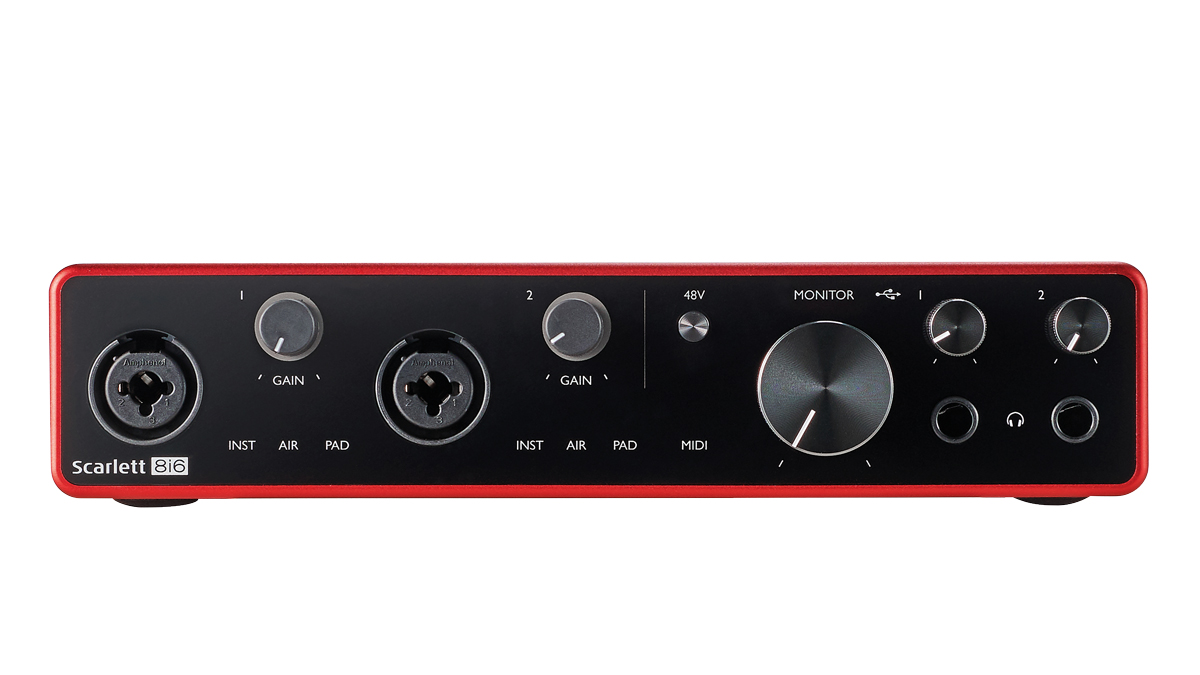MusicRadar Verdict
Slicker than ever, and the Focusrite 4i4 and 8i6 make good use of the excellent Focusrite Control software to deliver an upgraded user experience.
Pros
- +
New, improved preamp design.
- +
‘Air’ transformer stage emulation.
- +
Both compatible with Focusrite Control software.
Cons
- -
Scarlett 8i6 requires external PSU.
MusicRadar's got your back
Focusrite’s Scarlett USB audio interfaces combine excellent sonics and audio flexibility at an affordable price point, and the third generation units have just landed.
Up for review we have two of the mid-sized units (the 8i6 and 4i4) from a range that starts with the pocket-sized Solo, and tops out at the impressively equipped 18i20. All units in the range have received a physical and technical upgrade, with improved preamps (now up to 56dB gain), balanced connectivity throughout, and the inclusion of Focusrite’s ISA transformer preamp emulation option (Air).
There’s now a slicker front panel with LEDs and the halo-style input level meters sitting below a shiny surface. Meanwhile, all units now use USB Type C connectors, although for the foreseeable future will ship with Type C to Type A cables. Finally, Focusrite is rolling out a new onscreen onboarding process that guides you through the setup from the moment you first plug in.
Looking specifically at the review units, both gain a couple of extra inputs over their predecessors (the 2i4 and 6i6). So, for the 4i4 you get two mic/line/instrument inputs with gain, two line-level TRS inputs and four TRS outputs. The 8i6 also has two mic/line/instrument inputs with gain, and gets four line-level TRS inputs, four TRS outputs and stereo S/PDIF in/out. Both units include MIDI in/out. For headphones, the 4i4 has one front panel output with level and the 8i6 two outputs with individual level. The larger interface requires an external PSU which, though understandable, is moderately annoying given it’s pretty compact. The smaller 4i4 is USB bus-powered.
As we’ve come to expect from the Scarlett series, the sonics are neutral and the drivers reliable
Both the 4i4 and 8i6 support Focusrite’s Control application, and this means that a number of settings including pad, line/Hi Z instrument selector, and the Air option mentioned above can only be set via the software. The app also handles low-latency monitoring, so there’s no direct monitoring knob as per the 2i4, although it’s worth noting that the 3rd Gen 2i2 and Solo interfaces continue to use this system. Whether you view this as extra flexibility or unnecessary complexity is personal preference, but I like the software option, particularly when you take into account that there’s an accompanying nifty iOS app that effectively adds in remote control capabilities as well. A further positive is the monitor mix system which allows easy creation of low latency mixes for each output stream. Finally, both interfaces support Focusrite’s Loopback feature, whereby a further mix panel allows you to quickly route inputs, DAW outputs or a custom blend of both back into the DAW.
As we’ve come to expect from the Scarlett series, the sonics are neutral and the drivers reliable, and both units operate at up to 192kHz. The Air option tilts the frequency response towards high frequencies, and this can be great for taming undesirable proximity or adding high frequency lift. There’s also a decent pack of bundled software including Ableton Live Lite 10, Pro Tools First Focusrite Creative Pack, Focusrite Red 2 and Red 3 plugin suite, Softube Time and Tone bundle, XLN Audio Addictive Keys and Focusrite Plug-In Collective. This is a solid refresh and both review models deliver a noticeable upgrade on predecessors.
- More of the best budget audio interfaces
Jon is a London based platinum award winning mixer, producer, composer and club remixer with a diverse CV that spans dance, pop, rock and music for media. He’s also a long term contributor to MusicRadar's music technology tutorials and reviews. Whether working alone or collaborating he usually handles final mixdowns, so you’ll also find MusicRadar peppered with his handy mixing tips.
“I used everything I knew about music”: How Green Day exceeded expectations with their most ambitious song
YouTube just added AI tools that makes musicians, library music and video editors redundant
“Every one of them said yes without hesitation": Hank Marvin and Roger Taylor have just remade a '60s classic for charity











